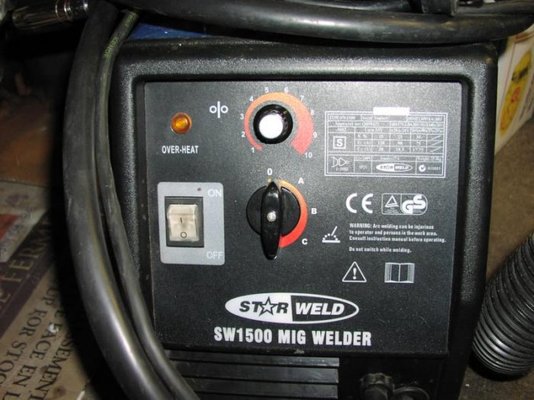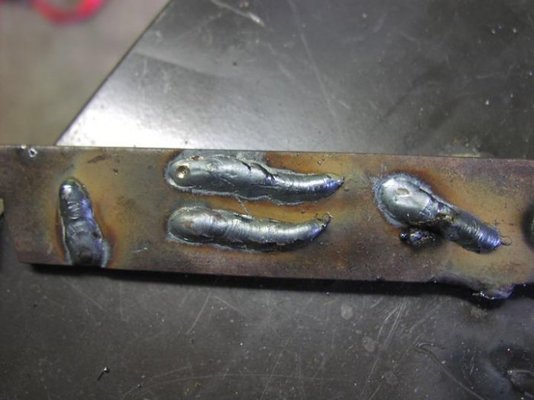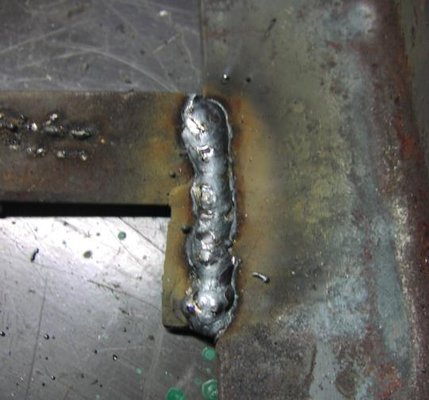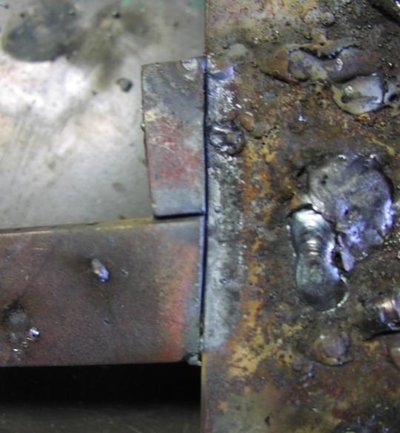I recently bought a "Starweld SW1500", and thought I would post a few pictures and initial test results here.
Please bear in mind that I am a beginner... but I do have my friend Matt visiting and he is an experinced welder and helped me get the settings right.
The SW1500 specs:
Single phase 240 volt supply, four power settings (A-D, A lowest), current range approximately 40-120 amps. CO2 gas supply from a D-type hire bottle. Tested with 0.8 mm and 0.6 mm wire.
This machine is available from hardware stores in New Zealand for around $600, and may be sold under other brand names (I've seen two others with control panels which look exactly the same, one branded as "Neweld"). This would probably correspond to a price of around 200 UK Pounds.
The welder has a reasonably solid feel. The wire reel and feeder mechanism look a bit cheap and crude, but seem to run smoothly (but see comments below). The gun seems pretty standard, and the earth clamp isn't sophisticated but seems to do the job.
We started with 0.8 mm wire and some bits of scrap about 4 mm thick. We quickly found that the wire feed speed adjustment was very sensitive and quite tricky. It took some very fine tweaking to get it running smoothly but once that was done we got some nice welds with good heat and penetration at the higher power settings. It seemed to weld pretty smoothly.
The photos show a couple of bits of 4mm thick scrap I welded together after only a short time playing with it - I was quite pleased with the result and how easy it was given I am a complete beginner. There was good penetration and you can see the heat had travelled through well.
Next we tried some thin steel from an old filing cabinet - about 0.7 mm. We couldn't get it to weld smoothly at all on the lowest power setting. Settings B and C worked quite nicely once the feed speed was right, but it was pretty easy to blow holes!
The photos show a vertical-down stitch tack weld Matt did on a corner (filling a gap). This could be done with care although mine wasn't as tidy.
We then tried 0.6 mm wire. This turned out to be less satisfying. We couldn't get it to maintain a satisfactory arc at the low power setting. It worked OK at C and D, but there wasn't a lot of advantage over the 0.8 mm wire (it still made holes in the thin sheet pretty easily). On the B setting it would arc but it wasn't very steady. I noticed that the wire length was fluctuating a lot (getting closer to the work then further away) and I could hear the feed motor changing note.
The wire feeds nicely when the torch is away from the work. One problem here is that the mains voltage is quite low (often down to 216 V) and fluctuates with load. Could it be possible that mains voltage fluctuations are being passed though to the feed motor? In any case, we concluded that it generally welds a lot better with 0.8 mm wire.
Overall, I was very pleased with how it went doing a weld on the thicker steel - it seemed easy to use and gave plenty of heat. Welding thinner steel was a little more tricky but I think it will do the job with practice. Matt comments that it seems like an OK welder for the cost - not the best welder ever, but usable. He thought it would probably go better on a better power supply.
I was pleased that I had reasonable success with it after only half an hour of playing around.
Please bear in mind that I am a beginner... but I do have my friend Matt visiting and he is an experinced welder and helped me get the settings right.
The SW1500 specs:
Single phase 240 volt supply, four power settings (A-D, A lowest), current range approximately 40-120 amps. CO2 gas supply from a D-type hire bottle. Tested with 0.8 mm and 0.6 mm wire.
This machine is available from hardware stores in New Zealand for around $600, and may be sold under other brand names (I've seen two others with control panels which look exactly the same, one branded as "Neweld"). This would probably correspond to a price of around 200 UK Pounds.
The welder has a reasonably solid feel. The wire reel and feeder mechanism look a bit cheap and crude, but seem to run smoothly (but see comments below). The gun seems pretty standard, and the earth clamp isn't sophisticated but seems to do the job.
We started with 0.8 mm wire and some bits of scrap about 4 mm thick. We quickly found that the wire feed speed adjustment was very sensitive and quite tricky. It took some very fine tweaking to get it running smoothly but once that was done we got some nice welds with good heat and penetration at the higher power settings. It seemed to weld pretty smoothly.
The photos show a couple of bits of 4mm thick scrap I welded together after only a short time playing with it - I was quite pleased with the result and how easy it was given I am a complete beginner. There was good penetration and you can see the heat had travelled through well.
Next we tried some thin steel from an old filing cabinet - about 0.7 mm. We couldn't get it to weld smoothly at all on the lowest power setting. Settings B and C worked quite nicely once the feed speed was right, but it was pretty easy to blow holes!
The photos show a vertical-down stitch tack weld Matt did on a corner (filling a gap). This could be done with care although mine wasn't as tidy.
We then tried 0.6 mm wire. This turned out to be less satisfying. We couldn't get it to maintain a satisfactory arc at the low power setting. It worked OK at C and D, but there wasn't a lot of advantage over the 0.8 mm wire (it still made holes in the thin sheet pretty easily). On the B setting it would arc but it wasn't very steady. I noticed that the wire length was fluctuating a lot (getting closer to the work then further away) and I could hear the feed motor changing note.
The wire feeds nicely when the torch is away from the work. One problem here is that the mains voltage is quite low (often down to 216 V) and fluctuates with load. Could it be possible that mains voltage fluctuations are being passed though to the feed motor? In any case, we concluded that it generally welds a lot better with 0.8 mm wire.
Overall, I was very pleased with how it went doing a weld on the thicker steel - it seemed easy to use and gave plenty of heat. Welding thinner steel was a little more tricky but I think it will do the job with practice. Matt comments that it seems like an OK welder for the cost - not the best welder ever, but usable. He thought it would probably go better on a better power supply.
I was pleased that I had reasonable success with it after only half an hour of playing around.











